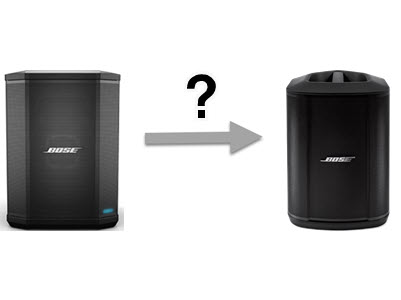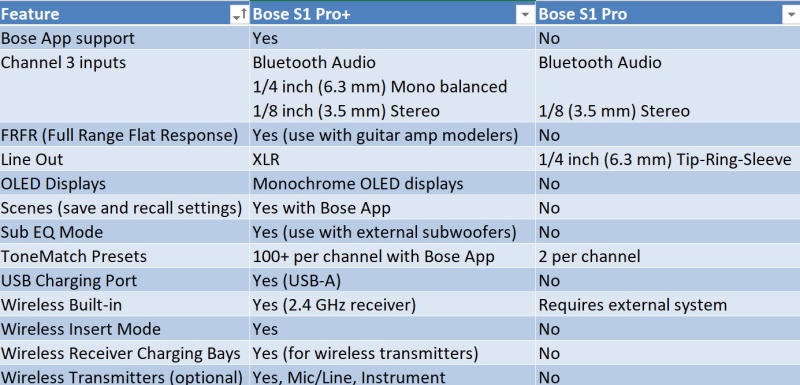Difference between revisions of "Do I Need to Upgrade from the S1 Pro to the S1 Pro+"
m |
m (→Background) |
||
| Line 9: | Line 9: | ||
=== Background === | === Background === | ||
| − | I have owned several {{S1 Pro}} since they were released in 2018. I've used them for small gigs, playing outdoors, computer speakers, family Karaoke, sitting in with friends, and occasionally as monitors when not using my L1 systems. | + | I have owned several {{S1 Pro}}s since they were released in 2018. I've used them for small gigs, playing outdoors, computer speakers, family Karaoke, sitting in with friends, and occasionally as monitors when not using my L1 systems. |
Most of the time I use my L1 Pro systems because I need larger coverage than the either model of S1 provides. But when portability was essential, or being relatively unobtrusive in an intimate setting was important, an S1 was the right tool for the job | Most of the time I use my L1 Pro systems because I need larger coverage than the either model of S1 provides. But when portability was essential, or being relatively unobtrusive in an intimate setting was important, an S1 was the right tool for the job | ||
| Line 19: | Line 19: | ||
===== Wireless Connectivity ===== | ===== Wireless Connectivity ===== | ||
| − | As I got accustomed to taking the {{S1 Pro}} to outdoor, or intimate settings, I enjoyed not having to plug into an AC power source. Eventually, I added wireless transmitters for my microphones and guitars. | + | As I got accustomed to taking the {{S1 Pro}} to outdoor, or intimate settings, I enjoyed not having to plug into an AC power source. Eventually, I added wireless transmitters for my microphones and guitars for even more convenience. Of course, there was the added inconvenience of having pack and keep track of transmitters and receivers, and keeping charging them between shows. |
===== ToneMatch Presets ===== | ===== ToneMatch Presets ===== | ||
Revision as of 23:35, 31 July 2024
Contents
I have an S1 Pro. Do I need the S1 Pro+?
Without close examination, the S1 Pro+ looks very similar to the S1 Pro system and the basic performance characteristics are similar. I was happy with my S1 Pro systems, so I ignored the new model for several months. I now have two S1 Pro+ complete with two wireless transmitters for each. This article is about what I've learned.
Background
I have owned several S1 Pro systems since they were released in 2018. I've used them for small gigs, playing outdoors, computer speakers, family Karaoke, sitting in with friends, and occasionally as monitors when not using my L1 systems.
Most of the time I use my L1 Pro systems because I need larger coverage than the either model of S1 provides. But when portability was essential, or being relatively unobtrusive in an intimate setting was important, an S1 was the right tool for the job
Wish List
There weren't many things I wished for in the S1 Pro system.
Phantom Power
Initially, I wished that the S1 Pro system had phantom power to support my preferred microphone, the Neumann KMS 105. Eventually, I found the Sennheiser MD 445, a wonderful dynamic microphone that does not need phantom power. It's not a replacement for the Neumann, but for any application where I'd use the S1 Pro system, it's a terrific performer.
Wireless Connectivity
As I got accustomed to taking the S1 Pro system to outdoor, or intimate settings, I enjoyed not having to plug into an AC power source. Eventually, I added wireless transmitters for my microphones and guitars for even more convenience. Of course, there was the added inconvenience of having pack and keep track of transmitters and receivers, and keeping charging them between shows.
ToneMatch Presets
The S1 Pro system had two ToneMatch Presets per channel (Microphone, Acoustic Steel-stringed Guitar). I wished it had more options for ToneMatch Presets, especially using different microphones and instruments.
Operating with a Subwoofer
The best way to use the S1 Pro system with a subwoofer (e.g., Bose Sub1) is to send the source signal to the Subwoofer, and send a high-pass signal from the Subwoofer to the S1 Pro system. This way, the low frequencies were handled by the Subwoofer and only the mid-high frequencies were sent to the S1 Pro system. Unfortunately, routing the signal this way meant you couldn't use the S1 Pro system as the input for microphones, instruments, or Bluetooth. You'd almost certainly need to use a mixer, like the Bose T4S for all the inputs, and send the T4S output to the Subwoofer.
Comparing the differences
Here's a quick run down of some of the major differences (see table at the end of this article for a more complete list).
Bose App Support
This gives you remote control of all the major functions of the S1 Pro+, just like the L1 Pro systems. The S1 Pro system works with the Bose Connect App, but that supports Bluetooth streaming, but not remote control.
Channel 3 Inputs
The S1 Pro system channel 3 input has 1/4 Tip-Ring-Sleeve balanced, line-level input. I use this for daisy-chaining or instruments like keyboards. It also has a 1/8 Tip-Ring-Sleeve Stereo Aux input.
Channel 3 has Bass and Treble (but no reverb). The S1 Pro system Channel 3 input has only the 1/8 Tip-Ring-Sleeve Stereo Aux input.
What Else
Although I never wished to play music via Bluetooth or to manage the L1 Model II with my phone or tablet, I've come to appreciate these features in the L1 Pro32.
If you have Bose Smart Home speaker (e.g., Bose Soundbar 700), you can add an L1 Pro system to a group and have sound from the Smart Home speaker and the L1 Pro simultaneously.
Bottom Line
I didn't need the S1 Pro+. The S1 Pro systems have served me well.
The S1 Pro+ can do everything the S1 Pro system can do, and fits into every situation as well or better.
The new features were not must-haves for me, but having spent some time with the S1 Pro+ I wouldn't be willing to go back.
Comparison Table
|
This article expresses my opinion and experience. Please post comments to Twitter @ST_Muso or LinkedIn @STPro. Thank you — ST. |

